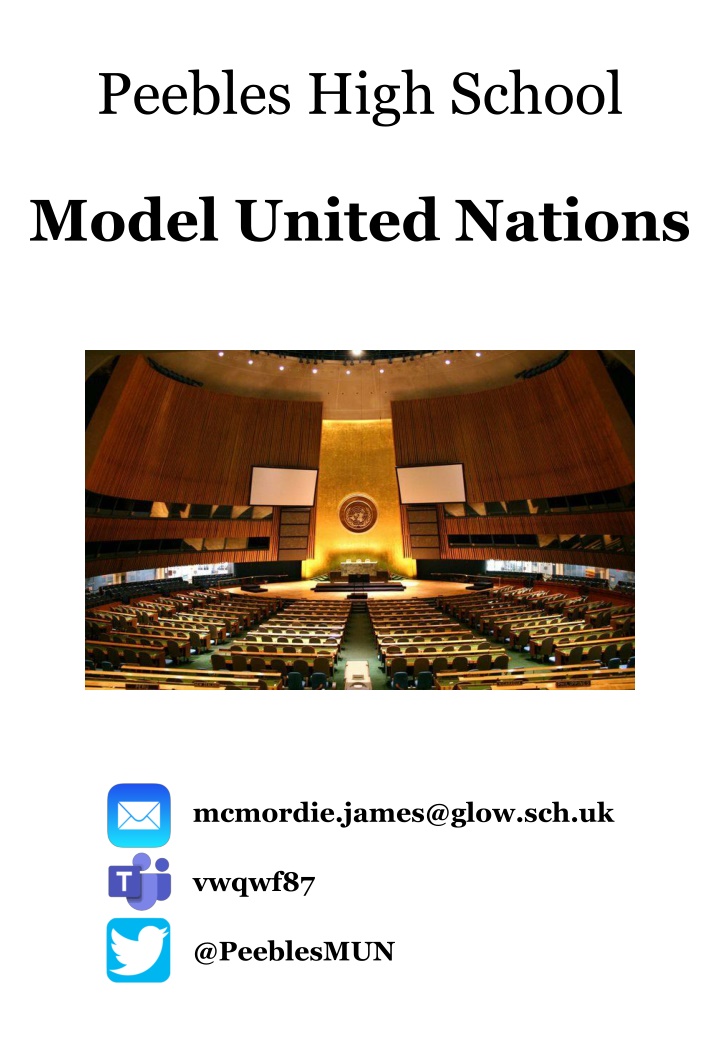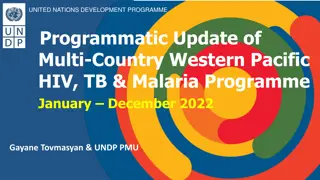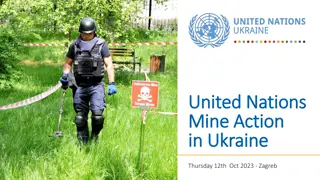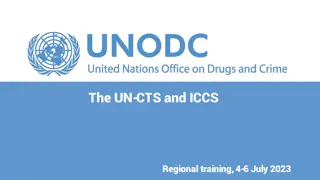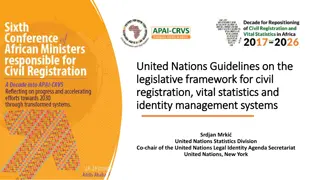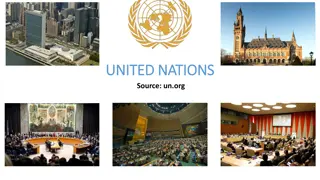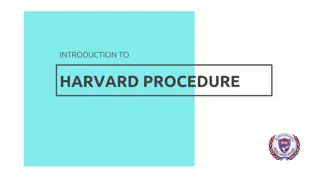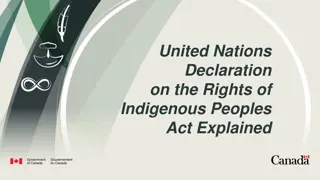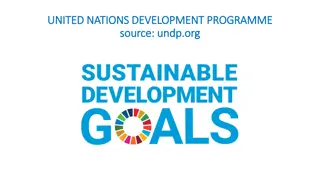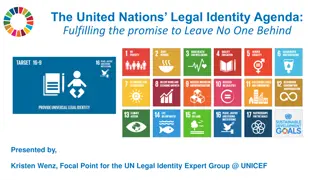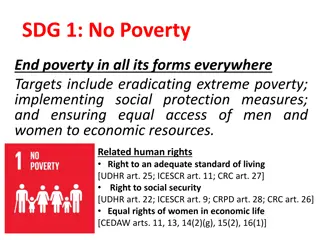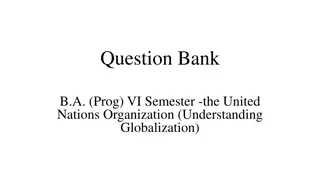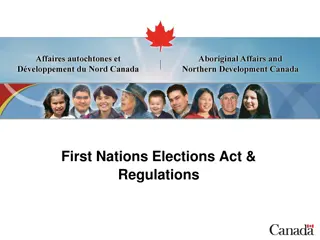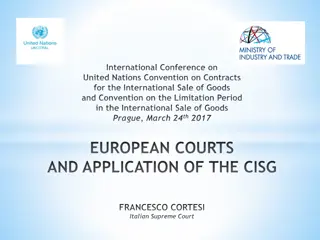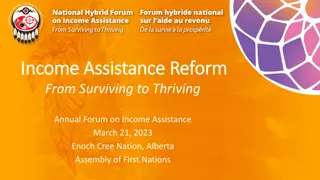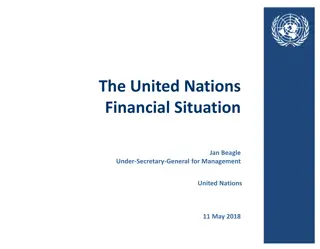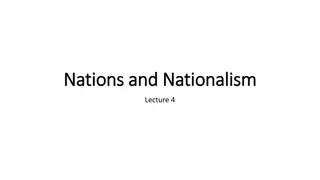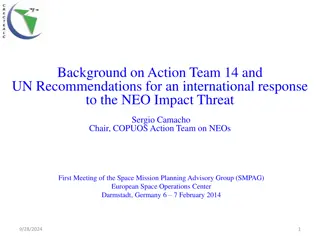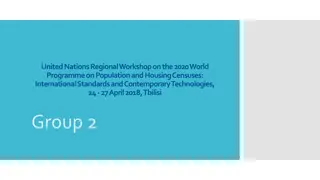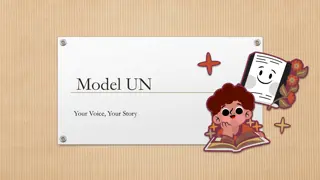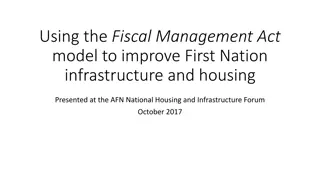Model United Nations
The United Nations is a crucial global organization dedicated to maintaining peace and addressing various global issues. Model United Nations, a simulation of the UN, allows participants to engage in diplomatic activities, draft resolutions, and tackle real-world problems. Learn about key terms, representation, resolution writing, and the significance of MUN participation.
Download Presentation

Please find below an Image/Link to download the presentation.
The content on the website is provided AS IS for your information and personal use only. It may not be sold, licensed, or shared on other websites without obtaining consent from the author.If you encounter any issues during the download, it is possible that the publisher has removed the file from their server.
You are allowed to download the files provided on this website for personal or commercial use, subject to the condition that they are used lawfully. All files are the property of their respective owners.
The content on the website is provided AS IS for your information and personal use only. It may not be sold, licensed, or shared on other websites without obtaining consent from the author.
E N D
Presentation Transcript
Peebles High School Model United Nations mcmordie.james@glow.sch.uk vwqwf87 @PeeblesMUN
Contents 1. What is the United Nations? 2. What is Model United Nations? 3. What are some key terms? 4. How does Model United Nations work? 5. How do I read resolutions? 6. How do I write resolutions? 7. How do I represent my country? 8. How do I evaluate resolutions? 9. Why should I get involved in M.U.N.? 10.How can I get more involved with M.U.N.?
1. What is the United Nations? The United Nations (U.N.) was set up after the Second World War with the aim of ensuring lasting peace. Since then 193 countries have joined the organisation and the U.N. has expanded to deal with a wide range of issues including climate change, human rights and economic development. There are two key committees within the United Nations: the General Assembly and the Security Council. The General Assembly includes every country in the world but the Security Council has only 15 members. It is the General Assembly s role to represent every nation in the world and the Security Council is expected to provide leadership especially in an emergency. Five countries the USA, UK, France, Russia and China are permanent members of the Security Council. The other ten are elected on a regular basis. Together these fifteen countries respond to crises and can, if they deem it necessary, authorise military action.
2. What is Model United Nations? Model United Nations (also known as M.U.N.) is a simulation of the United Nations. Like diplomats in the UN, M.U.N. participants must work together to find solutions to real-world problems, through writing, resolutions. debating and voting on M.U.N. follows a format which may be a little daunting for new participants. However, rest assured that you will quickly become familiar with many of the key terms. We hope that with time you will feel comfortable contributing to debates though you will never be forced to do this. Through this guide, we hope to provide clarity to those who would like to know more about M.U.N. and give you the ability to participate in our weekly debates as well as occasional conferences in Scotland and further afield.
3. What are some key terms? Abstain: During a vote on a resolution, a delegate may choose to abstain by voting neither yes nor no . Amendment: A proposed change to a resolution which adds, removes or changes an operative clause in a draft resolution. Chair: The delegate that ensures the debate is conducted according to proper procedure ensuring that all delegates have a fair chance to be heard. Delegate: The student representing a particular country. Operative Clause: A paragraph on a resolution which calls for action to help to solve the issue at hand. Placard: A sign given to delegates showing their country s name. You need to raise this placard in the air if you wish to speak during the debate. Pre-amble: the first part of a resolution where the situation or problem is summarised. Resolution: A document outlining a country s action plan to tackle a specific issue. They are submitted to the chair, debated during committee sessions and eventually voted on. Signatory: A country which signs a resolution or amendment, showing its support. Veto: The ability to block a resolution from passing in Security Council. It can only be used by China, France, Russia, UK and USA.
4. How does Model United Nations work? Every debate follows a similar format time for the resolution, time against the resolution and voting procedure. Time For the Resolution: 1. A resolution is submitted and the delegate who has written the resolution makes a short speech to explain their resolution and why other delegates should vote for it. 2. After this speech, the delegate can be asked questions on their resolution these are called Points of Information (POI s) 3. Once the delegate has finished, any other delegate may speak in favour of the resolution and can also be asked POI s. 4. The chair decides when to start the next stage of the debate. Time Against the Resolution: 1. Any delegate may speak against the resolution and can also be asked POI s. 2. Amendments can be submitted. The delegate proposing the amendment must read the amendment and then explain their thinking. This delegate can also be asked POI s. 3. Once an amendment is submitted, any other delegate may speak in favour or against the amendment. Delegates may also propose amendments to amendments and these will also be debated. 4. The chair decides when to start the next stage of the debate.
4. How does Model United Nations work? Voting Procedure: 1. Once the debate is finished, delegates will vote using their placards. 2. Amendments are voted on first. Delegates cannot abstain on amendments they can only abstain on the resolution overall. 3. If an amendment to the amendment passes the WHOLE amendment passes. If an amendment to the amendment fails, delegates will then vote on the original amendment. 4. Once all amendments have been voted on, there will be an overall vote on the resolution (including any amendments). Delegates may choose to vote yes, no or abstain on the resolution overall. 5. Permanent Security Council members may only veto emergency debates. 6. Delegates may clap if an amendment or resolution passes they may not if it fails.
5. How do I read resolutions? Resolutions are all about trying to create solutions to the world s problems. Here s one recent example with some explanations. This section tells us the topic and the countries that are supporting this resolution. These are the operative phrases. They are specific actions that the writer of this resolution thinks will solve this problem. We will discuss, change and vote on these during the debate. This is the pre-amble. They are a series of observations about the problem we are hoping to solve. These do not propose any actions and so are not subject to debate.
6. How do I write resolutions? Follow these steps to write a good resolution: 1. Do your research about the problem: 1. What are the causes of the problem? 2. What impact is the problem having? 3. What has already been tried? 2. Think about your country s point of view: 1. Are you affected by the problem? 2. Are your friends/allies affected? 3. Write the pre-amble: 1. Use the facts you have discovered in your research. 2. Use the phrases on the next page to start each sentence. 3. Refer to the UN Charter, the Declaration of Human Rights, previous UN resolutions, etc 4. Remind delegates of previous actions taken 5. Remind delegates why this is as significant problem. 4. Write the operative phrases: 1. Use the phrases on the next page to start each sentence Be specific what do you want to do? Carefully consider your language demanding is aggressive, suggesting is less so. 2. Consider what other countries might object to. 3. Less is more: few UN resolutions have more than 5 operative phrases. 4. Be bold but not silly. You can do radical things but not crazy things!
7. How do I represent my country? On the back of every placard there is a basic guide to that country. This should help you to figure out the likely views of the member state you are representing. Government and Human Rights Democracies tend to prefer cooperation with others, whereas dictators often prefer to be left alone. Countries with strong human rights records favour more UN action on human rights, countries with poor human rights don t. Democracies are often keen to promote democracy and human rights. Dictatorships often oppose UN action against other dictatorships out of fear that they too may face UN action some day. Economy and Development Wealthy countries may be reluctant to contribute to UN actions that don t directly benefit them. Less wealthy countries will be reluctant to contribute especially if wealthier countries don t. Countries that rely on trade with others are less likely to want conflict than those that are self-reliant. Domestic Issues Leaders have to keep one eye on public opinion, especially in democracies where there might be an election soon. Leaders will have to ensure national parliaments will support the decisions they make at the United Nations. Foreign Policy Proximity matters if the problem is nearby, countries are more likely to want to act. Work with your allies, keep an eye on your rivals and above all else, don t get on the wrong side of the more powerful countries.
8. How do I evaluate resolutions? There are many factors to consider when evaluating a resolution. As well as considering your own country s point of view, you may want to consider the factors below. International Law and National Sovereignty 1. Do previous resolutions require the UN to act in this situation? 2. Has the United Nations acted in this kind of situation before? 3. Would this action commit the United Nations to similar actions in the future in other situations? 4. Is the United Nations interfering unnecessarily in one nation s internal affairs? 5. What are the consequences if the United Nations does not act? Practicality and Efficiency 1. Does the United Nations have the resources to carry out this action? 2. Is the most efficient way to use the United Nations resources? 3. Are members of the United Nations willing to provide resources? 4. Are there alternatives that could be more practical or effective? 5. Would it be more effective for other organisations to take the lead in resolving this situation?
9. Why should I get involved in M.U.N.? Model United Nations links to a wide range of topics that we study in Modern Studies, Geography and History. In Modern Studies for instance we will learn about human rights, democracy, prejudice, terrorism, crime and much more. Model UN will put you ahead of the game and help you make sense of these topics. Model UN also helps you learn important skills that will benefit you inside and outside school. Teamwork, communication skills, critical thinking and leadership skills are just some of the skills you will gain. Above all else, Model UN is all about shaping the world that we share. This is your opportunity to have your say and to develop your ideas about how can make our world a better place. You can also make new friends across different year groups and even in other schools when we attend Model UN conferences. In the coming years we hope to travel to Model UN conferences in Dublin, Belfast and Bath.
10. How can I get more involved with M.U.N.? This is your club. Not the committee's, not Mr McMordie's it's yours to lead, mould and shape. With that in mind, you can choose how you want to get involved. 1. Take part in our debates through asking questions and making speeches. Carry out research at home to prepare for debates. Chair debates and help maintain order. Welcome new people and encourage others to come. Join the committee (elected in May) and help lead the club. 2. 3. 4. 5. However you get involved, know that you are really welcome here. Thank you for your interest and we look forward to seeing you at Model UN soon. :)
